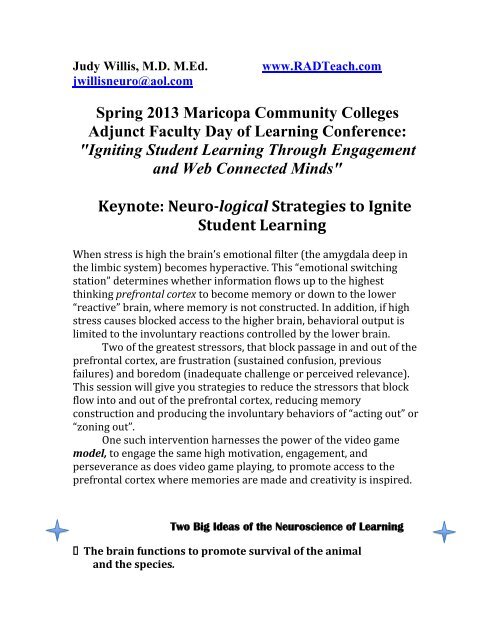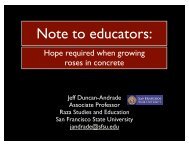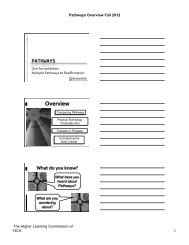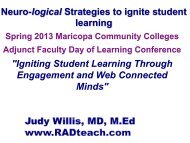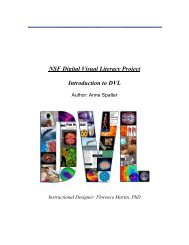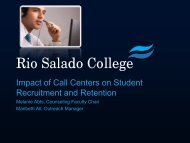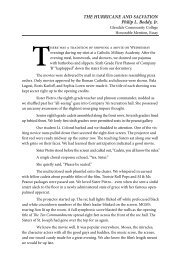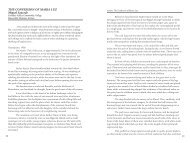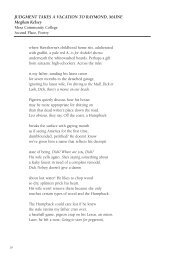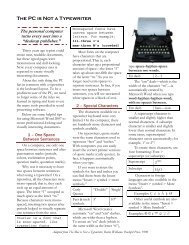Handout from Keynote Speaker, Dr. Judy Willis - Maricopa Center ...
Handout from Keynote Speaker, Dr. Judy Willis - Maricopa Center ...
Handout from Keynote Speaker, Dr. Judy Willis - Maricopa Center ...
Create successful ePaper yourself
Turn your PDF publications into a flip-book with our unique Google optimized e-Paper software.
<strong>Judy</strong> <strong>Willis</strong>, M.D. M.Ed.<br />
jwillisneuro@aol.com<br />
www.RADTeach.com<br />
Spring 2013 <strong>Maricopa</strong> Community Colleges<br />
Adjunct Faculty Day of Learning Conference:<br />
"Igniting Student Learning Through Engagement<br />
and Web Connected Minds"<br />
<strong>Keynote</strong>: Neuro-logical Strategies to Ignite<br />
Student Learning<br />
When stress is high the brain’s emotional filter (the amygdala deep in<br />
the limbic system) becomes hyperactive. This “emotional switching<br />
station” determines whether information flows up to the highest<br />
thinking prefrontal cortex to become memory or down to the lower<br />
“reactive” brain, where memory is not constructed. In addition, if high<br />
stress causes blocked access to the higher brain, behavioral output is<br />
limited to the involuntary reactions controlled by the lower brain.<br />
Two of the greatest stressors, that block passage in and out of the<br />
prefrontal cortex, are frustration (sustained confusion, previous<br />
failures) and boredom (inadequate challenge or perceived relevance).<br />
This session will give you strategies to reduce the stressors that block<br />
flow into and out of the prefrontal cortex, reducing memory<br />
construction and producing the involuntary behaviors of “acting out” or<br />
“zoning out”.<br />
One such intervention harnesses the power of the video game<br />
model, to engage the same high motivation, engagement, and<br />
perseverance as does video game playing, to promote access to the<br />
prefrontal cortex where memories are made and creativity is inspired.<br />
Two Big Ideas of the Neuroscience of Learning<br />
The brain functions to promote survival of the animal<br />
and the species.
To do so the human brain has evolved to seek patterns<br />
and pleasure.<br />
© 2012 <strong>Judy</strong> <strong>Willis</strong><br />
Key Understandings <strong>from</strong> Neuroscience<br />
about Emotion, the Brain, and Learning<br />
• Emotions influence where new information is processed in the brain. For<br />
learning to become memory it must be directed through the emotional filter<br />
(amygdala) along the route to the reflective, higher brain – the prefrontal<br />
cortex.<br />
• High stress reduces information flow through the amygdala (emotional<br />
filter) to and <strong>from</strong> the cognitive/reflective brain (Prefrontal Cortex – PFC).<br />
• During high stress, the survival instinct takes reactive control and<br />
responses are directed by the involuntary “lower” brain with output limited<br />
to fight/flight/freeze responses (act out/zone out).<br />
• The mammalian brain is wired to withhold effort when experience predicts<br />
a low probability of success.<br />
• The human brain can be “rewired” to reverse effort withholding when<br />
instruction follows the video game model: Buy-in, achievable challenge, and<br />
frequent feedback of incremental goal progress.<br />
• The power behind the video game “model” motivation and perseverance is<br />
the intrinsic reinforcement of the dopamine-reward response to accurate<br />
predictions and feedback of challenges achieved.<br />
• Goals that are clear, personally relevant, and believed to be achievable<br />
challenges are needed to promote brain “buy-in” and effort when previous<br />
efforts have not yielded goal success.<br />
2
How Emotion Impacts the Brain and Influences Learning<br />
Common teacher concern: “Some of my students ‘act out’ or ‘zone out’<br />
in class. What can I do?”<br />
This section answers the above question with information about<br />
attitude, the amygdala, and achievable challenge.<br />
Amygdala: The amygdala is a part of the limbic system that is found in<br />
the temporal lobe of the brain. The amygdala can be thought of as a<br />
“fork in the road” or a “switching station” on the way to the “thinking<br />
brain” (prefrontal cortex).<br />
After information passes through the RAS, it enters the amygdala.<br />
The amygdala then directs the information to one of two places.<br />
The information can be sent to either the lower REACTIVE brain<br />
or to the REFLECTIVE “thinking brain” (prefrontal cortex).<br />
In the reactive lower brain, information is responded to with an<br />
automatic fight, flight or freeze response.<br />
In the reflective “thinking brain” (prefrontal cortex) conscious<br />
thought, logic and judgment can be used to respond to new<br />
information.<br />
What determines if the amygdala directs information to the reflective “thinking<br />
brain” (prefrontal cortex) or to the reactive lower brain?<br />
When a person is in a state of high or sustained stress or fear:<br />
© 2012 <strong>Judy</strong> <strong>Willis</strong><br />
3
New information coming through the sensory intake areas of the<br />
brain cannot pass through the amygdala’s filter to gain access to<br />
the reflective prefrontal cortex.<br />
Incoming information is conducted to the lower, reactive brain.<br />
The lower, reactive brain has a limited set of behavior outputs:<br />
fight, flight, or freeze.<br />
Students during these states of stress-directed behavior may be<br />
misidentified as suffering <strong>from</strong> disorders i.e. ADHD, petit mal<br />
epilepsy (staring spells), oppositional-defiant syndrome.<br />
Stress can reduce the ability of the hippocampus to effectively use<br />
working memory.<br />
Sources of school-related stress:<br />
Until the prefrontal cortex (PFC) is more mature, students are<br />
more reactive than they are reflective, especially when they<br />
perceive stress.<br />
Stress comes in many forms for students:<br />
o The boredom of already having mastery of the information<br />
being taught<br />
o No personal relevance: not being sufficiently interested in a<br />
topic or aware of how the topic relates to a student’s own<br />
interests or prior knowledge<br />
o Frustration of previous failures, being confused, and falling<br />
behind<br />
o Fear of being wrong if asked to speak in class, answer<br />
questions, or present their work orally<br />
o Test-taking anxiety<br />
o Physical and language differences<br />
o Feeling overwhelmed by work load and unable to organize<br />
time to respond to these demands<br />
Reducing stress<br />
If stress is reduced, and a person is in a relaxed and alert state,<br />
information can pass through the amygdala and on to the reflective<br />
“thinking brain” (prefrontal cortex) for long-term memory and<br />
executive function processing. Students can build skills that allow the<br />
prefrontal cortex to over-ride the lower brain’s reactive impulses.<br />
© 2012 <strong>Judy</strong> <strong>Willis</strong><br />
4
• Participating in new learning requires students to take risks that<br />
are often beyond their comfort zones. Steps should be taken to<br />
reduce stress during these times.<br />
• Students can learn how to become aware of their own stress and<br />
strategies for relaxing and refocusing.<br />
Promote Passage through Amygdala to PFC<br />
Guide students to:<br />
Monitor and control emotions<br />
Reflect before acting on emotions<br />
Experience control over sensory responsiveness (e.g. hearing a<br />
sound longer)<br />
Visualization: imaginary bubble to deflect hurtful actions & words<br />
Self-calm (deep-breath, observe themselves <strong>from</strong> “above”)<br />
Learning how the brain processes input helps students develop more<br />
reflective PFC control of over their reactive lower brains.<br />
© 2012 <strong>Judy</strong> <strong>Willis</strong><br />
Promoting Growth Mindsets<br />
People with a fixed mindset believe they are born with a certain<br />
amount of intelligence and skill, and that is all they will ever have. They<br />
believe that once they fail, there is no point in trying again, because they<br />
have reached their limit.<br />
Those with a growth mindset believe that people are given a certain<br />
amount of intelligence and skill, just as they have a certain body type,<br />
but that people have the potential to grow their intelligence and skill<br />
with hard work, just like a muscle. (Carol Dweck’s research)<br />
The Power of the Video Game Model:<br />
The Brain Seeks Patterns and Pleasure<br />
Dopamine is the source of Pleasure<br />
Video and computer games are compelling because they offer<br />
individualized achievable challenges and frequent feedback of<br />
5
incremental progress that are physiologically rewarded with the<br />
intrinsic satisfaction produced by the brain chemical dopamine.<br />
At the outset, a player is presented with a goal. The player begins at<br />
level one, and through trial and error (feedback) builds enough skills to<br />
ultimately pass level one.<br />
The next level challenges the player’s newly developed skills, but<br />
ultimately, through sustained effort, practice, and persistence the player<br />
succeeds and continues to progress through the levels.<br />
The player receives ongoing feedback and the dopamine boosting<br />
pleasure of incremental goal progress – reaching the next level. She<br />
feels the pride of knowing that her effort caused her success (intrinsic<br />
reinforcement). The player then seeks the greater challenge of the next<br />
level so she can continue to experience the pleasure of dopamine<br />
reward.<br />
Power of Dopamine<br />
Dopamine, when released in amounts that exceed what is needed for<br />
carrying signals across synapses, travels throughout the brain. The extra<br />
dopamine acts as a neurochemical with more widespread impact.<br />
When dopamine levels go up, the following behaviors are more<br />
prominent:<br />
• Pleasure<br />
• Creativity<br />
• Motivation<br />
• Curiosity<br />
• Persistence and perseverance<br />
The following activities increase dopamine levels:<br />
• Positive interactions with peers<br />
• Enjoying music<br />
• Being read to<br />
• Acting kindly<br />
• Expressing gratitude<br />
• Humor<br />
• Optimism<br />
• Choice<br />
© 2012 <strong>Judy</strong> <strong>Willis</strong><br />
6
• Movement<br />
• Feeling the intrinsic satisfaction of accurate predictions and<br />
challenges achieved<br />
© 2012 <strong>Judy</strong> <strong>Willis</strong><br />
The Video Game Model in the<br />
Classroom<br />
Video Game Model Includes:<br />
Goal buy-in<br />
Individualized achievable challenges<br />
Frequent feedback or awareness of incremental goal progress<br />
Goal Buy-in – Personal Relevance<br />
With goals designed to connect with students’ interests and<br />
authentic performance tasks that they consider relevant, students<br />
want the knowledge tools they need to succeed. Students are then in<br />
the ideal state for motivated, attentive learning because they want to<br />
know what they have to learn.<br />
Examples of Personal Goal Relevance<br />
Show students how what they are about to study relates to their<br />
lives or the world around them. Watch a relevant video, such as<br />
those relating to math and science found at:<br />
http://www.thefutureschannel.com/<br />
Connect a unit with current events<br />
Read aloud something curious that relates to the topic at hand<br />
Before a lesson or unit, tell a narrative about the life of the author,<br />
scientist, historical figure, or mathematician when he/she was<br />
about the age of your students<br />
Personalize information by connecting the topic to a person or<br />
place relevant to students (e.g. book author anecdote)<br />
Discuss the “So what?” factor. Why should students WANT to<br />
know what you have to teach them? You can discuss with<br />
students how information connects to the “real world” or to their<br />
lives.<br />
7
How are they going to use the new information after you teach it<br />
to them? Are they going to discuss it with a classmate, or teach it<br />
to younger students?<br />
“Talking back to the Text” is an interactive reading strategy that<br />
helps students become personally engaged with what they are<br />
reading. Students begin by writing questions and prompts on<br />
post-it notes or other small papers that they can insert into their<br />
text. Some questions are prediction questions the student will<br />
answer before reading, others will be responded to while the<br />
student is reading.<br />
Before reading the students writes and answers prediction<br />
questions:<br />
o I think you’ll be telling me…<br />
o I already know things about YOU so I predict.....<br />
During reading students can complete the following<br />
questions or prompts:<br />
o You are similar to what I have learned before, because<br />
you remind me of...<br />
o I would have preferred a picture of...(or<br />
sketch/download their own)<br />
o I didn’t know that and I find it interesting because …<br />
o I disagree because…<br />
o This is not what I expected which was….<br />
o This gives me an idea for …<br />
o I want to know more about this than you have to<br />
offer. I’ll find out by…<br />
o I have a different way of interpreting this information<br />
which is…<br />
o I won’t let you get away with this statement, so I’ll<br />
check your source by ……<br />
o This could be a clue to help me answer the “Big<br />
Question” because ….<br />
o I think this will be on the test because…<br />
After reading the students use duplicate post-it prompts and<br />
can add to their earlier predictions<br />
© 2012 <strong>Judy</strong> <strong>Willis</strong><br />
8
Achievable Challenge<br />
An achievable challenge is one in which a student has the capacity (or<br />
skills to develop the capacity) to meet an ambitious goal. As Goldilocks<br />
would say, the challenge is “not too hard, not too easy, but just right!” An<br />
achievable challenge is exists within Vygotsky’s “zone of proximal<br />
development”.<br />
If a challenge is too easy a student will become bored, which leads to stress,<br />
and ultimately disengagement <strong>from</strong> learning. If a challenge is too difficult a<br />
student will experience frustration and hopelessness, which if sustained or<br />
frequent also leads to excessive stress. However, when facing an<br />
achievable challenge that is just within their reach, students avoid the<br />
detrimental states of stress, and the amygdala is able to pass information to<br />
and <strong>from</strong> the prefrontal cortex.<br />
Achievable challenges prevent stress by avoiding boredom and<br />
frustration: One way of helping students to develop a growth mindset is to<br />
provide them with achievable challenges and alert them to their progress.<br />
Achievable challenge lowers stress by reducing boredom and<br />
frustration and motivating perseverance and effort.<br />
Students are most motivated by the expectation of a dopamine reward<br />
when they learn at their individualized levels of achievable challenge.<br />
Providing students with achievable challenges reduces the reactive states<br />
resulting <strong>from</strong> the stress of boredom or frustration and promotes the video<br />
game model of motivation.<br />
In a “video game” model of teaching, all students would be learning in their<br />
personal zone of achievable challenge at all times. Students would be<br />
frequently assessed to determine their appropriate “zone”, they would set<br />
and reset goals throughout learning, and they would receive the individual<br />
support needed to overcome setbacks and obstacles.
Increasingly it is becoming possible for students to learn foundational facts<br />
at their individuated levels of achievable challenge via instruction through<br />
computer programs. While some students learn foundational facts <strong>from</strong> the<br />
computer within their personal zone of achievable challenge, their teachers<br />
will have more flexibility to facilitate projects requiring executive functions<br />
and building concept knowledge.<br />
What can teachers do to enable students to work within their achievable<br />
challenge level?<br />
Lower the barriers, not the bar: Communicate high expectations for all<br />
students and provide the differentiation and support so students can<br />
achieve their goals.<br />
• Pre-assessments<br />
• Activate prior knowledge<br />
• Cultivate a “growth mindset”<br />
• Build motivation<br />
• Highlight incremental progress<br />
• Formative assessments and corrective feedback<br />
• Flexible groups<br />
• Scaffolding Examples<br />
* Key vocabulary lists especially for English language learners for<br />
context specific words<br />
* Manipulatives for revising math concept misunderstandings<br />
* Online math tools like ALEKS.com assesses a student's readiness,<br />
provides tasks and feedback at the student's level of readiness, and teacher<br />
feedback.<br />
* Reading comprehension building strategies such as “talk back to the<br />
book”, preview bold print subtitles, “three-color highlighting”, jigsaw, turn<br />
headings of texts into questions to answer as the chapter is read.<br />
© 2012 <strong>Judy</strong> <strong>Willis</strong><br />
Incremental Progress Awareness<br />
The video game model is promoted by frequent formative assessment<br />
and feedback and by student awareness of incremental goal progress.<br />
In general we experience an intrinsic reward when we realize that we are<br />
making progress due to our practice and effort. Even noticing small changes<br />
10
can be helpful. For example, having students keep a graph of how their<br />
reading fluency improves depending on how much they practice can be<br />
very motivating.<br />
The video game model gives students the opportunity to recognize both the<br />
intrinsic pleasure of incremental progress (“I got it” experience) and the<br />
cause/effect that putting in the effort to practice/review brings them<br />
progressively closer to GOAL success.<br />
Students who feel alienated in school need additional support to regain<br />
their confidence and feel motivated towards reaching a challenging goal. If<br />
struggling academically has always been a source of disappointment for<br />
them, help students recall when they have been successful towards<br />
reaching a goal (e.g. music, sports, art, making friends, cooking something<br />
new, etc.).<br />
Intrinsic pleasure of incremental progress<br />
Ongoing formative assessments with feedback, reteaching, opportunities<br />
for self-corrections, and metacognition are needed for all students to build<br />
understanding and progress at achievable challenge levels of success.<br />
Analytic Rubrics for incremental progress awareness<br />
Analytic rubrics are consistent with the amygdala positive benefits of<br />
video game model of achievable challenge and incremental progress.<br />
Rubrics allow all students to:<br />
Understand what is expected and how they can achieve steps of<br />
incremental progress along the way toward overall goal<br />
Experience the choice (a dopamine booster) of achievable challenge –<br />
where they will focus effort<br />
Develop metacognitive awareness so they can self-motivate<br />
(dopamine <strong>from</strong> intrinsic gratification)<br />
(REFERENCE: Nancy Pickett and Bernie Dodge. "Rubrics for Web Lessons." October<br />
2001)<br />
Rubric Generator Websites<br />
http://www.teachervision.fen.com/teaching-methods-and-<br />
© 2012 <strong>Judy</strong> <strong>Willis</strong><br />
11
management/rubrics/4524.html#ixzz1d2xZeJck<br />
http://rubistar.4teachers.org/index.php<br />
http://edtech.kennesaw.edu/intech/rubrics.htm<br />
http://myt4l.com/index.php?v=pl&page_ac=view&type=tools&tool=rubricmaker<br />
Developing Awareness that effort increases goal progress<br />
Conferences<br />
Portfolios<br />
Metacognition/class discussion<br />
Effort=Progress to Goal Graphs<br />
Help your students use graphs to see the connection between their<br />
work, practice, effort, and their progress<br />
Sample graphs: www.onlinecharttool.com<br />
Summary: In an amygdala-positive learning environment we see<br />
evidence of active learning and participating:<br />
Students observing and noticing with focused attention (without act<br />
out/zone out)<br />
• Students discovering, thinking and questioning<br />
• Students who are engaged, motivated, interested, self-sustained learners<br />
To promote a positive attitude so that information gets to the prefrontal<br />
cortex (PFC):<br />
Use curiosity promoting questions/demonstrations and make learning<br />
personalized for “buy-in”<br />
Have students work in their zone of “achievable challenge”<br />
Teach students how to recognize their progress towards a goal<br />
Website showing multiple examples of curriculum contents adapted to the video<br />
game model: http://ierg.net/lessonplans/unit_plans.php<br />
Website: WWW.RADTeach.com<br />
<strong>Judy</strong> <strong>Willis</strong>, M.D. M.Ed.<br />
jwillisneuro@aol.com<br />
© 2012 <strong>Judy</strong> <strong>Willis</strong><br />
12


